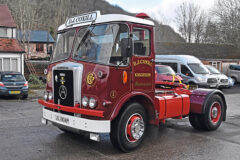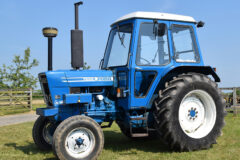1970 Ransomes Crusader 2800B combine in action this summer
Posted by Chris Graham on 19th October 2023
Peter Love heads to Kent to witness the evocative spectacle of a 1970 Ransomes Crusader 2800B combine harvester in action.

Ransomes Sims & Jefferies was renowned for producing well-balanced combines like this 1970 Crusader 2800B, owned by Rodney Broadley.
On 17th August, conditions were finally right at Home Farm in Lyminge, Kent, for Rodney Broadley to harvest a crop with his fabulous, 1970 Ransomes Crusader 2800B. A keen agricultural machinery enthusiast, and farmer/contractor, Rodney decided to plant 15 acres last year to harvest with his classic combine, after spraying-off the mustard.
Farming is in his blood and, when he was just 12, he was driving a Massey-Harris 780 tanker combine with 10ft cut on the neighbouring Longage Farm. The 780 cost £1,389 in 1954, he recalls. A Massey Ferguson 500, which came from Arter Brothers in Barham, Kent, was part of the family business, but later a Ransomes Cavalier joined the fold, and it was a Rolls-Royce compared to what had gone before, according to Rodney, although a small Claas Mercator 60 did the job effectively, too.
Last July, Rodney visited well-known combine dealer Rodney Cowle Machinery at Winkleigh, in Devon, and came away with a 1970 Ransomes Crusader. Registered KTW 769J, it was originally supplied by Ernest Doe, but ended up in Devon combining around 100 acres of barley, for 35 years.
It was in very good condition, and the 74hp Perkins 4.236 four-cylinder diesel engine ran like a dream. Some fabrication was required to get the reel up to scratch, but the Crusader certainly looked the part.
Ransomes had been involved in the development of the threshing machine before and after the farm workers’ rebellion (Swing Riots), which climaxed in 1830 and led to the Great Reform Act of 1832. Then, once everything had calmed down making farm mechanisation possible again, Ransomes & May (later May went on to form the highly-respected Brown & May Ltd. of Devizes) created a steam portable mounted with a threshing machine that was shown at the Royal Agricultural Society of England’s (RASE) annual show, in 1841, in Liverpool. Then, at the Bristol event the following year, it featured a simple drive system that enabled it to move.

The Crusader is perhaps not the best-looking combine, but it’s typical of RSJ in that it’s solid and reliable.
Despite such advances, horse-driven threshing machines were the ‘in thing’ until the 1860s, when the wheeled threshing box, as we now know it, took over – driven by steam portables at first, before the self-propelled traction engines took over, followed by internal combustion-powered tractors in the late ’30s.
In 1872, the RASE threshing machine trials took place in Cardiff, with 32 machines on site from more than a dozen manufacturers it’s said, with Ransomes taking one of the two major awards.
These threshing machines featured the rasp bar in 36-60in widths, with some even bigger examples for its burgeoning export market. Ransomes even made high-revving, American-style peg drums for export markets, too.
The company was still making threshing drums into the 1950s, along with clover hullers and auxiliary equipment, like self-feeders, elevators, chaff cutters, and so on. In fact, Ransomes was the biggest manufacturer of agricultural equipment in the world for some time and, today, Ransomes-Jacobson is part of Textron – making turf equipment in Ipswich, Suffolk.
Turning back in time, Ransomes, Sims & Jefferies Ltd. (RSJ), as it was called in later times (Ransomes had many partners over the centuries), saw the market for threshing drums deteriorate with the success of the Canadian-built Massey-Harris 21 combine in the early 1940s.

The Crusader powers up the hill, powered by its 74hp Perkins 4.236 engine.
RSJ experimented with a converted motorised threshing drum in 1946, but the trailed combine was heavy and bulbous, and the company was slow following it up. RSJ was never in a hurry, unfortunately.
It took the company until 1953 to get its act together, when it did a deal with Bolinder-Munktell, and the trailed MST 42 (42in drum) was manufactured in Suffolk from the following year. The model was made successfully in Britain for some years, and a larger, 56in trailed combine came along in 1959.
In 1956 Ransomes came up with its own design of self-propelled combine, called the 902, which was exhibited at Smithfield that year. It caused a sensation and was offered in two header sizes of 10ft or 12ft, but later export models were offered in larger 14ft and 16ft sizes.
Some were sold to Argentina, where RSJ had a strong market over the years, as well as to Chile, Syria and Egypt. Due to its close connection with Ford, it was powered by a 62hp, four-cylinder industrial engine, like the unit Dagenham was fitting in the Thames Trader lorry.
The blue Ransomes combine was solid and, in 1963, it was followed by the smaller 801 with 36in drum, Perkins engine and hydraulic table lift, called ‘Handimatic’. The 801 looked the part but wasn’t the greatest of sellers. Just a year later came the 1001 model, as the replacement for the 902, which is commonly referred to as a ‘beefed-up’ 801.

As the Ransomes eight-ton trailer was without its extension sides, it did not take long to fill.
Just two years later, at the Smithfield Show, the first Cavalier 12-14ft cut combine was shown. It featured modern technology in the form of a two-drum threshing system – the first was 45in x 8.75in, and the second was 45in x 24in. It had four straw walkers and worked very well. Ransomes had taken a giant leap forward in the combine market, but could it sell the idea?
The Cavalier featured a Ford six-cylinder engine and hydrostatic steering, and could harvest 7.5-9 tons per hour. It had one or two teething problems, but it was a good, solid machine in the end.
By then, RSJ’s management had become lethargic, and the business wasn’t in a great place but, by 1967, the Crusader had come along. Fitted with the brilliant 74hp Perkins 4.236 engine, the neat Crusader was like the Cavalier, with the same size lead drum – but the main drum had a diameter of 18in, and the header was either 10ft or 12ft.
When watching Rodney’s Crusader at work, one could see how well the RSJ double-drum system was working, with the straw and greenery coming out of the rear end steadily and a fine sample in the grain tank.
It would be 1976 when the RSJ combine story ended. The Super Cavalier had been introduced just two years before when the line at Nacton ground to a halt for the final time, but the company continued to produce and ‘badge-engineer’ equipment following the demise of its combine harvesters.
Alongside Rodney’s Crusader was proof of such machinery – a 1977 8-ton trailer, made by Pettit, that Rodney acquired earlier this year, and pulled by a 1978 Muir-Hill 121 with Dual Power. Rodney used such tractors on the farm and was keen to add one to his collection. He found one locally in 2022 and deemed it to be an ideal machine to undertake a bit of work, but it took serious effort to get it to a suitable condition.

Rodney’s Muir-Hill 121 and Ransomes trailer, built by Pettit of Lincolnshire.
The braking system required a great deal of reconditioning, and numerous oil seals were needed throughout the tractor. Parts of the nearside trumpet housing needed machining, as well as new bearings and seals, and the mudguards, lighting system and instrument panel also required attention to get the tractor right. Rodney is indebted to Lloyd Loaders (MH) Ltd. for the help he received when ordering parts for the 121.
Rodney achieved his aim of getting the tractor to a safe, useable state, and it was nice to see a trio of machines from the 1970s doing the job today just as they would have done 50 years ago.
Before I left, I was able to look over Rodney’s Ford Pre-Force 2000 Select-O-Speed tractor, which he purchased earlier this year. It wasn’t cheap to buy, but is a fascinating tractor that’s said to have worked around Ford’s Basildon site.
Rodney has found quite a bit of white paint on the tractor and would like to know if Ford’s factory tractors had a white livery? He’s purchased a trailer very similar to one the tractor would have pulled around the works when new, which will get the full ‘Rodney treatment’ in due course.
It was a pleasure to be in east Kent, enjoying the nostalgic harvest, and I’d like to thank Rodney for his time and for allowing me to take photographs.
* Since I met with Rodney, he’s managed to find an original Bostrom seat for the Muir-Hill 121 – at the Hellingly Festival of Transport – but is still looking for spare sieves for the Ransomes Crusader. If you have any, please get in touch (tm.ed@kelsey.co.uk).
This feature comes from the latest issue of Tractor & Machinery, and you can get a money-saving subscription to this magazine simply by clicking HERE

Previous Post
1970s Atkinson Borderer lorry wonderfully restored

Next Post
1977 Ford 7600; a classic utility winner!



